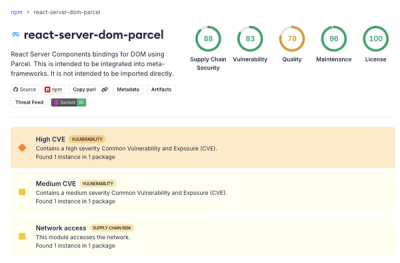
A set of higher-order components to turn any list into an animated, accessible and touch-friendly sortable list





Features
- Higher Order Components – Integrates with your existing components
- Drag handle, auto-scrolling, locked axis, events, and more!
- Suuuper smooth animations – Chasing the 60FPS dream 🌈
- Works with virtualization libraries: react-virtualized, react-tiny-virtual-list, react-infinite, etc.
- Horizontal lists, vertical lists, or a grid ↔ ↕ ⤡
- Touch support 👌
- Accessible: supports keyboard sorting
Installation
Using npm:
$ npm install react-sortable-hoc --save
Then, using a module bundler that supports either CommonJS or ES2015 modules, such as webpack:
import {SortableContainer, SortableElement} from 'react-sortable-hoc';
var Sortable = require('react-sortable-hoc');
var SortableContainer = Sortable.SortableContainer;
var SortableElement = Sortable.SortableElement;
Alternatively, an UMD build is also available:
<script src="react-sortable-hoc/dist/react-sortable-hoc.umd.js"></script>
Usage
Basic Example
import React, {Component} from 'react';
import {render} from 'react-dom';
import {SortableContainer, SortableElement} from 'react-sortable-hoc';
import arrayMove from 'array-move';
const SortableItem = SortableElement(({value}) => <li>{value}</li>);
const SortableList = SortableContainer(({items}) => {
return (
<ul>
{items.map((value, index) => (
<SortableItem key={`item-${value}`} index={index} value={value} />
))}
</ul>
);
});
class SortableComponent extends Component {
state = {
items: ['Item 1', 'Item 2', 'Item 3', 'Item 4', 'Item 5', 'Item 6'],
};
onSortEnd = ({oldIndex, newIndex}) => {
this.setState(({items}) => ({
items: arrayMove(items, oldIndex, newIndex),
}));
};
render() {
return <SortableList items={this.state.items} onSortEnd={this.onSortEnd} />;
}
}
render(<SortableComponent />, document.getElementById('root'));
That's it! React Sortable does not come with any styles by default, since it's meant to enhance your existing components.
More code examples are available here.
Why should I use this?
There are already a number of great Drag & Drop libraries out there (for instance, react-dnd is fantastic). If those libraries fit your needs, you should definitely give them a try first. However, most of those libraries rely on the HTML5 Drag & Drop API, which has some severe limitations. For instance, things rapidly become tricky if you need to support touch devices, if you need to lock dragging to an axis, or want to animate the nodes as they're being sorted. React Sortable HOC aims to provide a simple set of higher-order components to fill those gaps. If you're looking for a dead-simple, mobile-friendly way to add sortable functionality to your lists, then you're in the right place.
Prop Types
SortableContainer HOC
| axis | String | y | Items can be sorted horizontally, vertically or in a grid. Possible values: x, y or xy |
| lockAxis | String | | If you'd like, you can lock movement to an axis while sorting. This is not something that is possible with HTML5 Drag & Drop. Possible values: x or y. |
| helperClass | String | | You can provide a class you'd like to add to the sortable helper to add some styles to it |
| transitionDuration | Number | 300 | The duration of the transition when elements shift positions. Set this to 0 if you'd like to disable transitions |
| keyboardSortingTransitionDuration | Number | transitionDuration | The duration of the transition when the helper is shifted during keyboard sorting. Set this to 0 if you'd like to disable transitions for the keyboard sorting helper. Defaults to the value set for transitionDuration if undefined |
| keyCodes | Array | {
lift: [32],
drop: [32],
cancel: [27],
up: [38, 37],
down: [40, 39]
} | An object containing an array of keycodes for each keyboard-accessible action. |
| pressDelay | Number | 0 | If you'd like elements to only become sortable after being pressed for a certain time, change this property. A good sensible default value for mobile is 200. Cannot be used in conjunction with the distance prop. |
| pressThreshold | Number | 5 | Number of pixels of movement to tolerate before ignoring a press event. |
| distance | Number | 0 | If you'd like elements to only become sortable after being dragged a certain number of pixels. Cannot be used in conjunction with the pressDelay prop. |
| shouldCancelStart | Function | Function | This function is invoked before sorting begins, and can be used to programatically cancel sorting before it begins. By default, it will cancel sorting if the event target is either an input, textarea, select, option, or button. |
| updateBeforeSortStart | Function | | This function is invoked before sorting begins. It can return a promise, allowing you to run asynchronous updates (such as setState) before sorting begins. function({node, index, collection, isKeySorting}, event) |
| onSortStart | Function | | Callback that is invoked when sorting begins. function({node, index, collection, isKeySorting}, event) |
| onSortMove | Function | | Callback that is invoked during sorting as the cursor moves. function(event) |
| onSortOver | Function | | Callback that is invoked when moving over an item. function({index, oldIndex, newIndex, collection, isKeySorting}, e) |
| onSortEnd | Function | | Callback that is invoked when sorting ends. function({oldIndex, newIndex, collection, isKeySorting}, e) |
| useDragHandle | Boolean | false | If you're using the SortableHandle HOC, set this to true |
| useWindowAsScrollContainer | Boolean | false | If you want, you can set the window as the scrolling container |
| hideSortableGhost | Boolean | true | Whether to auto-hide the ghost element. By default, as a convenience, React Sortable List will automatically hide the element that is currently being sorted. Set this to false if you would like to apply your own styling. |
| lockToContainerEdges | Boolean | false | You can lock movement of the sortable element to it's parent SortableContainer |
| lockOffset | OffsetValue* | [OffsetValue*, OffsetValue*] | "50%" | WhenlockToContainerEdgesis set totrue, this controls the offset distance between the sortable helper and the top/bottom edges of it's parentSortableContainer. Percentage values are relative to the height of the item currently being sorted. If you wish to specify different behaviours for locking to the top of the container vs the bottom, you may also pass in anarray(For example:["0%", "100%"]). |
| getContainer | Function | | Optional function to return the scrollable container element. This property defaults to the SortableContainer element itself or (if useWindowAsScrollContainer is true) the window. Use this function to specify a custom container object (eg this is useful for integrating with certain 3rd party components such as FlexTable). This function is passed a single parameter (the wrappedInstance React element) and it is expected to return a DOM element. |
| getHelperDimensions | Function | Function | Optional function({node, index, collection}) that should return the computed dimensions of the SortableHelper. See default implementation for more details |
| helperContainer | HTMLElement | Function | document.body | By default, the cloned sortable helper is appended to the document body. Use this prop to specify a different container for the sortable clone to be appended to. Accepts an HTMLElement or a function returning an HTMLElement that will be invoked before right before sorting begins |
| disableAutoscroll | Boolean | false | Disables autoscrolling while dragging |
* OffsetValue can either be a finite Number or a String made up of a number and a unit (px or %).
Examples: 10 (which is the same as "10px"), "50%"
SortableElement HOC
| index | Number | | ✓ | This is the element's sortableIndex within it's collection. This prop is required. |
| collection | Number or String | 0 | | The collection the element is part of. This is useful if you have multiple groups of sortable elements within the same SortableContainer. Example |
| disabled | Boolean | false | | Whether the element should be sortable or not |
FAQ
Running Examples
In root folder, run the following commands to launch React Storybook:
$ npm install
$ npm start
Accessibility
React Sortable HOC supports keyboard sorting out of the box. To enable it, make sure your SortableElement or SortableHandle is focusable. This can be done by setting tabIndex={0} on the outermost HTML node rendered by the component you're enhancing with SortableElement or SortableHandle.
Once an item is focused/tabbed to, pressing SPACE picks it up, ArrowUp or ArrowLeft moves it one place backward in the list, ArrowDown or ArrowRight moves items one place forward in the list, pressing SPACE again drops the item in its new position. Pressing ESC before the item is dropped will cancel the sort operations.
Grid support
Need to sort items in a grid? We've got you covered! Just set the axis prop to xy. Grid support is currently limited to a setup where all the cells in the grid have the same width and height, though we're working hard to get variable width support in the near future.
Item disappearing when sorting / CSS issues
Upon sorting, react-sortable-hoc creates a clone of the element you are sorting (the sortable-helper) and appends it to the end of the <body> tag. The original element will still be in-place to preserve its position in the DOM until the end of the drag (with inline-styling to make it invisible). If the sortable-helper gets messed up from a CSS standpoint, consider that maybe your selectors to the draggable item are dependent on a parent element which isn't present anymore (again, since the sortable-helper is at the end of the <body>). This can also be a z-index issue, for example, when using react-sortable-hoc within a Bootstrap modal, you'll need to increase the z-index of the SortableHelper so it is displayed on top of the modal (see #87 for more details).
Click events being swallowed
By default, react-sortable-hoc is triggered immediately on mousedown. If you'd like to prevent this behaviour, there are a number of strategies readily available. You can use the distance prop to set a minimum distance (in pixels) to be dragged before sorting is enabled. You can also use the pressDelay prop to add a delay before sorting is enabled. Alternatively, you can also use the SortableHandle HOC.
Wrapper props not passed down to wrapped Component
All props for SortableContainer and SortableElement listed above are intentionally consumed by the wrapper component and are not passed down to the wrapped component. To make them available pass down the desired prop again with a different name. E.g.:
const SortableItem = SortableElement(({value, sortIndex}) => (
<li>
{value} - #{sortIndex}
</li>
));
const SortableList = SortableContainer(({items}) => {
return (
<ul>
{items.map((value, index) => (
<SortableItem
key={`item-${index}`}
index={index}
sortIndex={index}
value={value}
/>
))}
</ul>
);
});
Dependencies
React Sortable HOC only depends on invariant. It has the following peerDependencies: react, react-dom
Reporting Issues
If believe you've found an issue, please report it along with any relevant details to reproduce it. The easiest way to do so is to fork the react-sortable-hoc basic setup sandbox on CodeSandbox:

Asking for help
Please do not use the issue tracker for personal support requests. Instead, use Gitter or StackOverflow.
Contributions
Yes please! Feature requests / pull requests are welcome.









